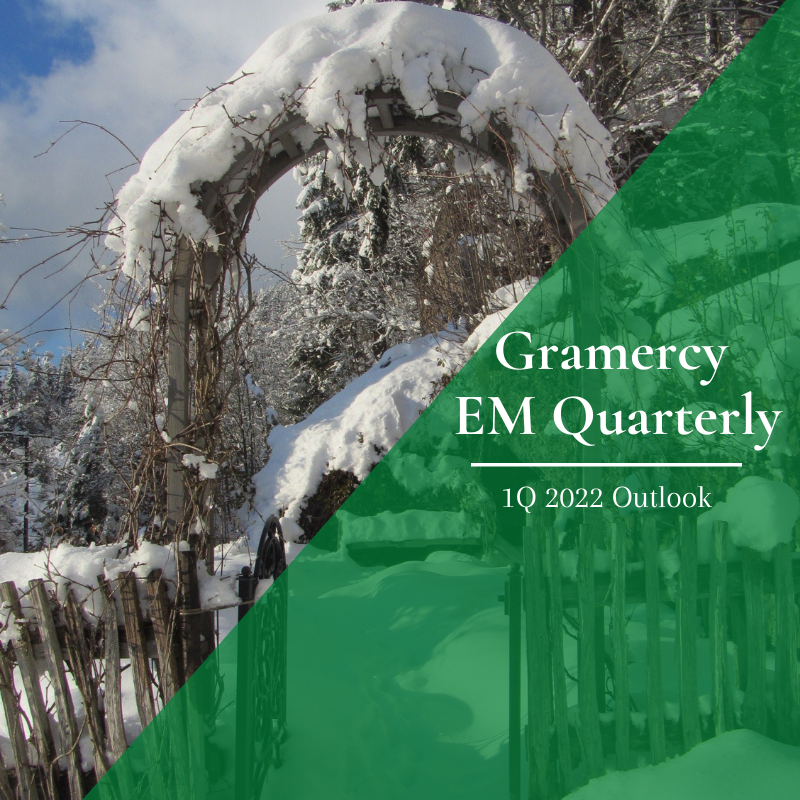Authored by:
Robert Koenigsberger, Managing Partner & Chief Investment Officer
Mohamed A. El-Erian, Chair
Petar Atanasov, Senior Vice President & Co-Head of Sovereign Research
Kathryn Exum, Senior Vice President & Co-Head of Sovereign Research
January 12, 2022
Decoding the Global Macro Environment: A Top-down Perspective and the Related Implications for Emerging Markets Heading into 1Q 2022
The global economy enters 2022 with both old and new questions hanging over the prospects for a better economic and financial year for emerging markets (“EM”). The range of potential outcomes remains significant, calling for investment approaches that emphasize selectivity, vigilance, and granular analyses.
Dispersion, the theme we highlighted a year ago, will remain in play this year, especially as COVID-19 continues to influence health outcomes and economic interactions. This is particularly the case in a world of continued and significant variations in countries’ vaccination rates, their approach to virus management, and the degree of financial flexibility to offset disruptions. This is also a situation that enables the emergence of new variants, suggesting that full post-pandemic normality is likely to be delayed well into 2022 if not beyond.
The 2020-21 themes of COVID-19 and economic dispersion will interact in 2022 with newer themes, thus opening up a greater range of possible economic and financial outcomes for emerging economies and their markets. These newer themes include (i) the reaction of monetary policy in advanced countries to the persistence of high inflation and, in particular the actions of systemically important central banks, (ii) what the Chinese government’s emphasis on “common prosperity” implies for certain sectors, and (iii) geo-political risks pertaining in particular to China-U.S. tensions and Russia-Ukraine hostilities. Getting these themes right will be key to both managing risks and benefiting from what have become even more attractive relative valuations. They will also influence entry points into pressured names with considerable upside.
Given its unique global influence, there will be a lot of interest in Federal Reserve policy in 2022, especially as inflation proves higher and more present than the central bank had expected. Having initially mis-characterized the inflation dynamics and thus fallen well behind developments on the ground, the Fed has been left with a rather small window to deliver an orderly pivot away from its decade-long policy of massive and predictable liquidity injections. Failure to do so risks a policy mistake that would undermine both global growth and financial stability. It is no wonder some emerging economies have already started hiking interest rates, adding internal EM dispersion to the external one.
The Chinese government’s decision in 2021 to partially rein in what it deemed to be excessive private sector activities contributed to the continued under-performance of markets there, posing an interesting question for investors: take advantage of what are now bigger valuation gaps based on fundamentals or wait for greater clarity on domestic political drivers. The right call has broader implications given that, at least until now, the waves of dislocations in the Chinese capital markets have had no meaningful spillovers on other emerging markets.
Finally, there is the geopolitical angle. The question here is not whether the multiple points of tension will remain. They will. Rather, it is about the associated risk of political miscalculations. This is particularly the case for China-U.S. given that several emerging economies are still – understandably – operating with a “dual-option model” that heavily engages China on economic issues and the U.S. on national security ones.
The uncertainties for emerging economies associated with these factors will intensify as 2022 progresses and as the role of central bank liquidity injections transitions from being dominant to taking a back seat. The higher risks they pose come at a time when there is already considerable value.
Such a balance will place a premium on individual countries’ policymaking apparatus, their financial resilience, their sensitivity to sudden reversal in capital flows, and the credibility of their institutions. A premium also relates to individual companies and investment situations.
The overall investment environment calls for careful quality differentiation, responsive liquidity management, the ability to absorb volatility, and agility to exploit the type of price overshoots inherent to an asset class that is still in its maturation phase and is having to navigate multiple external transitions.
What is likely to become clear during 2022 is that EM’s value relative to other asset classes, as well as within the asset class itself, is at a fundamental level more differentiated than current market pricing suggests.
Themes Influencing Investment Decisions in 1Q 2022
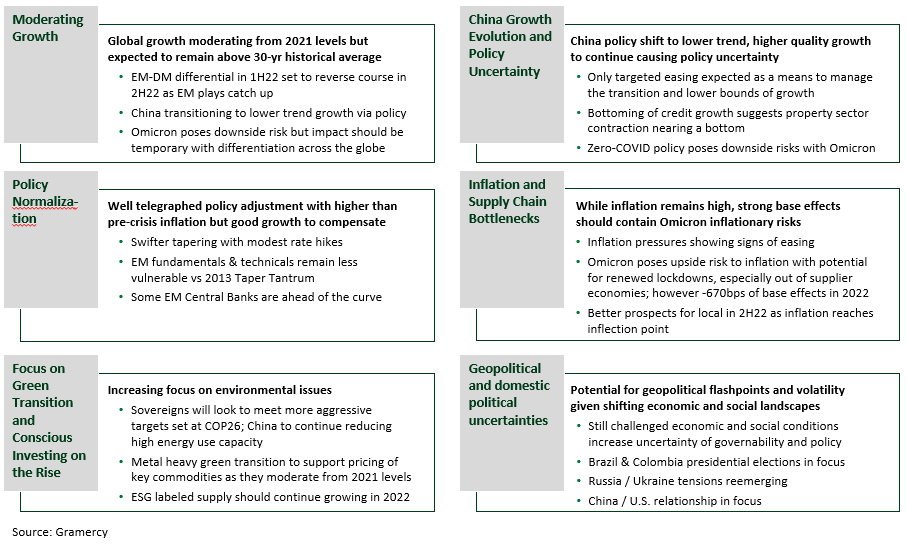
Historically high global growth to continue despite moderation as recovery deepens
The world economy should continue to expand at a robust rate in 2022 at an estimated 4.5%, comfortably above the 30-year pre-pandemic average of 3.6%. As an incremental scale back of fiscal and monetary support and base effects roll-off lowering momentum globally, we expect private investment to remain strong while normalization of still-elevated savings continues to support consumption. The ongoing pandemic and variant evolution will likely drive bouts of select softness in economic activity, albeit to a lesser extent than previous waves, as the world vaccination and booster rates continue to rise, science related to symptom management progresses and many economies take more targeted restriction approaches. The maintenance of a zero-tolerance strategy in China, at least in the near-term, will partially slow supply chain and price normalization. However, we expect the overall growth-inflation mix to improve as the year progresses with sustained strong demand and the alleviation of bottlenecks as base effects take hold.
Emerging markets activity relative to developed markets growth could improve by mid-year as these economies catch-up following comparative weakness in 2021. Growth estimates for next year indicate that the EM-DM growth differential should move back into positive territory by 2Q. Many EM countries have front-loaded tightening in 2021, most notably China, in contrast to the U.S. and other developed market economies which should in part help to deliver swifter improvements in inflation opening the door for a pause in rate hikes or modest easing in select cases.
In China, we envisage growth and credit impulse stabilization in 1Q with a likelihood for bouts of weakness on property sector related stress and Omicron or other COVID-19 variant spread, but ultimately expect real GDP to hover around 5.0% for the year. In the near-term, the external sector should remain supportive while a gradual pick-up in infrastructure investment should help offset real estate investment slack. We think the authorities will maintain a prudent approach to monetary policy but be flexible with an aim to provide ‘reasonable and ample liquidity’ as the most recent Politburo statement outlined. On the fiscal side, there should be a modest rebound in local government bond issuance albeit with greater scrutiny on the use of proceeds going forward.
Downside risks to the outlook remain elevated given the unprecedented nature of the economic recovery and policy support. The largest potential challenge to our constructive view on growth is a more prolonged and higher inflation overshoot in the U.S. and globally which prompts a more aggressive, unanticipated central bank response, which collectively trigger a more material slowdown in economic momentum. Given eroded policy space and social fragilities, this could cascade a series of negative events globally and drive market volatility.
Exhibit 1: Growth rates remain elevated as recovery progresses; EM-DM inflection point?
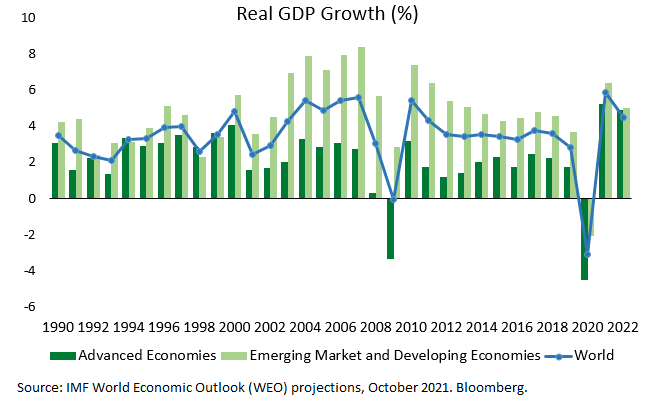
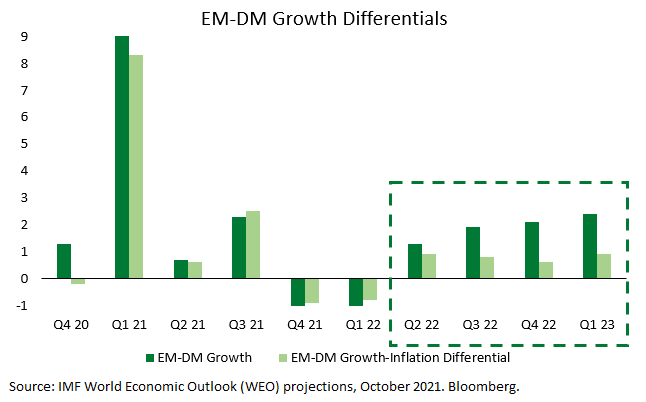
Inflationary pressures are starting to show signs of easing across global economies, but remain subject to virus dynamics and policy responses
During 2021, inflation in many industrialized economies and emerging markets reached the highest levels in decades and materially overshot consensus expectations at the end of 2020. Elevated pressure on consumer prices has been driven by a unique confluence of supply and demand factors triggered by the pandemic. On the supply side, various bottlenecks have limited the ability of producers to meet strong demand for goods. On the demand side, a shift in global consumption patterns toward goods and away from services due to the pandemic has been reinforced by stimulus programs and excess savings globally. Furthermore, tight labor market conditions in a number of sectors across global economies have been putting upward pressure on wages, especially in lower income brackets, creating an even stronger pull-push environment for inflationary pressures. As such, prevailing global political, social, and economic trends in 2021 underpinned a “perfect inflation storm”.
As we look forward to 1Q 2022, stronger signals have started to emerge that the acute inflationary pressures that dominated 2021 might be easing. As recoveries across global economies consolidate and we approach the second anniversary of the COVID-19 pandemic’s onset, the massive monetary and fiscal stimulus unleashed by authorities in most economies to counteract the fallout will continue to be gradually withdrawn (see Exhibit 2). All else being equal, tapering of central banks’ asset purchasing programs and fiscal consolidation across most DM and EM economies should have a disinflationary impact.
Exhibit 2: Tapering of asset purchases by systemic central banks and withdrawal of fiscal stimulus should have a disinflationary impact
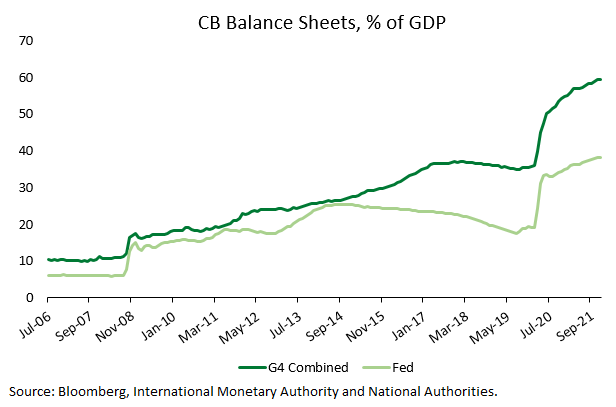
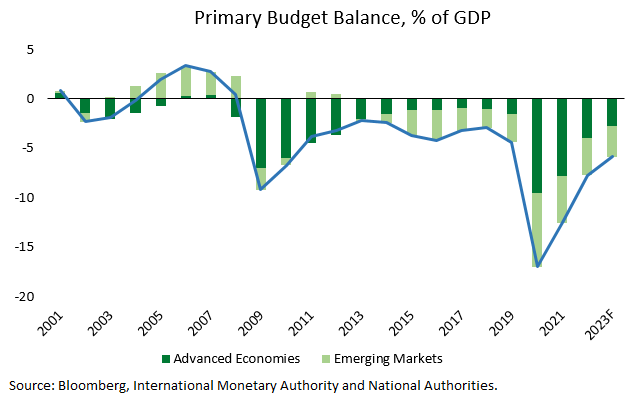
In addition, clearer signals are starting to emerge in high frequency economic data that some of the major inflation-causing bottlenecks in global supply chains throughout 2021 might have peaked. This comes alongside a likely moderation of global energy price increases that were a key inflation driver in 2021 (see Exhibit 3). Last but not least, we also consider statistical base effects that we expect to turn supportive to disinflationary dynamics in 1Q21 and grow stronger as the year progresses.
Exhibit 3: Global shipping costs appear to have peaked and energy prices are starting to come off highs
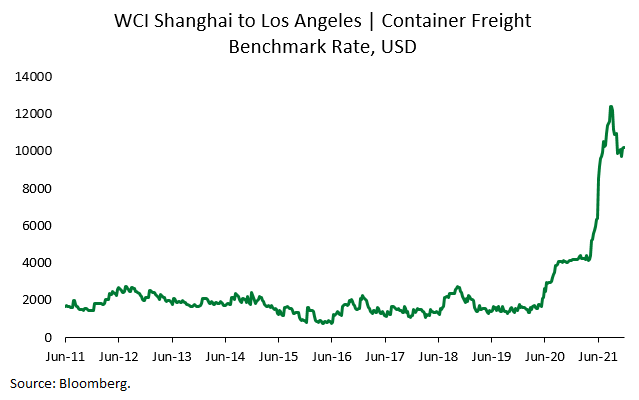
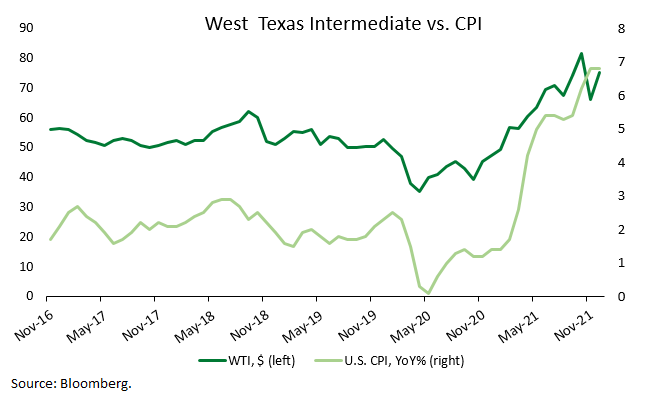
Potentially more benign inflation dynamics and outlook in early 2022 suggest a lower probability of a materially different monetary policy path/reaction function by the Fed and other systemic central banks relative to expectations priced in by markets. However, the inflation outlook remains subject to the virus trajectory and new variants such as the quickly spreading Omicron, which might lead to a return to widespread restrictions on economic activity/participation. If such a scenario materializes, it would likely unwind the recent easing of supply bottlenecks and worsen the inflation outlook.
As such, although not our base case, we remain vigilant for a downside scenario in which inflation remains elevated while GDP growth disappoints. In such a scenario, a number of economies might face “stagflation”, i.e. low/declining growth and elevated/accelerating inflation. Central banks might be forced to increase interest rates faster than expected, derailing economic recoveries and disrupting markets accustomed to a long-lasting paradigm of abundant, cheap liquidity. EM as an asset class would suffer significant headwinds and volatility under such a scenario. As such, fundamental credit differentiation, one of our key themes in 2021, remains relevant in 2022 and could matter even more.
The path and pace of monetary policy normalization by the systemic global central banks will be key for EM market performance in 2022. Recent market pricing suggests around 80 bps of Fed hikes in 2022, followed by another 60 bps in 2023. This is consistent with approximately three hikes in 2022, and inflation overshooting would need to be significant enough to alter the scenarios that already incorporate higher DM rates next year.
As rates increase from a low base and the highly accommodative global economic policy backdrop starts to turn incrementally less supportive, we believe that EM as an asset class is on balance in a better position today relative to the so-called “taper tantrum” of 2013. On the negative side, sovereign debt burdens have increased across the board in the last several years, especially during the COVID-19 crisis response, so vulnerability to increasing rates is higher for many governments. However, other key credit and technical metrics for EM are in a much better shape. For example, external balances in EM are materially healthier compared to 2013. In addition, credit bubbles do not seem to be a widespread/systemic problem at present, while EM is also enjoying a considerably more benign technical environment, after several years of underperformance/outflows. As such, looking forward to 1Q22, under our base case, we continue to expect fundamentals-driven performance dispersion among sovereign and corporate credits, but no major outflows from EM asset classes.
Sustainability: The next iteration of the recovery
We anticipate further deepening of ESG related policies and investment in 2022, including specific action plans and public / private budgets associated with more aggressive 2030 NDC targets committed at COP26 late this year. Emerging market countries with open economies highly linked to EU trade and investment flows will likely be incentivized to be leaders with respect to energy transition and mitigation efforts via both stick and carrot approaches. This includes consequences of carbon border adjustment mechanism implementation and growing availability of bilateral investment funds such as the $8.5bn commitment from developed nations to South Africa as agreed at COP26 to support the country’s transition from coal-sourced power. Multilateral institutions will likely further their financing tools related to ESG, and climate in particular, with potential for links to further SDR increases or reallocation. Meanwhile, the SDG and ESG related fixed income market should continue to expand albeit with the cadence in part linked to broader external rate conditions.
Commodity inputs for the global energy transition and green technology, including copper, nickel, cobalt, and lithium, will continue to grow in demand as investment pipelines are formed and launched. Top producer and reserve countries are emerging markets and include Chile, Peru, Indonesia, DRC, China, Philippines, and Brazil. Countries that effectively deploy the robust environmental and institutional standards to mining these metals should be most successful in sustainably maximizing the benefits of their natural resources over the next decade.
In the near-term, natural disasters linked to climate change are likely to continue to grow in frequency, posing credit risks and volatility for the most vulnerable. Central banks are likely to further explore and implement regulation and policy around climate related stress testing, increasing the cost of and reducing financing to, environmental laggards.
Geopolitical and domestic political events to watch in 2022
China-U.S. relations will remain mixed with tension in technology and national security related sectors with some room for modest trade de-escalation. We anticipate further pressure related to U.S. de-listings of China ADRs and Chinese VIE regulation in an aim to drive decoupling in the technology and data arenas. Domestic political factors amid the Party Congress in China in October may give rise to increased Taiwan risks later in the year but our case remains for status quo despite some heightened tensions. The U.S. mid-terms will be in focus with market expectations for a split Congress and prospects for Republican control of both houses. While near-term policy implications should be somewhat limited as gridlock is likely to grow in the second half of Biden’s term, the medium-term consequences of a potential Trump return or at a minimum, a highly contentious 2024 election, will gradually begin to influence market assumptions.
In Latin America, we continue to expect domestic politics to trump geopolitical developments in the near-term as the region faces the political repercussions of the pandemic as outlined in previous reports. Brazil and Colombia presidential elections will be in the spotlight and drive market sentiment. In Brazil, we expect a noisy and polarizing environment leading up to the October 2022 presidential elections, likely pitting current President Bolsonaro against former President Lula in a clash of conservative vs. leftist ideologies, keeping markets on the edge. Investors will be looking for signals on economic policy priorities from the main candidates in the context of projected flat GDP growth and a challenging fiscal outlook. In Colombia, legislative (in March) and presidential (in May) elections carry critical importance for the sovereign credit trajectory, following the loss of investment grade status in mid-2020. Far-left former Bogota Mayor Gustavo Petro is poised to be a competitive candidate, while the rest of the field is still uncertain, but should crystalize after the parliamentary and primary presidential elections in March. The emergence of strong moderate/centrist candidate(s) would be welcomed by markets, while consolidation of Petro’s lead would likely trigger increasing concerns about a potential “Peru scenario” in Colombia. We anticipate momentum to build early in the year on an Argentina-IMF agreement, and while our base case is not for material developments in Venezuela, we see potential scope for incremental sanctions relief as international dialogue resumes.
Tensions between Russia and the U.S./EU/NATO over Ukraine will continue to simmer in 2022. However, a hot conflict involving overt military action by Russia on/in Ukraine remains a fat-tail event for the time being, in our view. High level security talks between the U.S. and Russia set to begin in January signal a shared preference for using diplomacy to tackle the key thorny geopolitical issues, including Ukraine. Thus, market concerns about potential military escalation in the region should continue to ease in the near-term, supporting a recovery in both countries’ market assets from oversold levels. We remain of the view that markets tend to assign too high probability of military conflict involving Russia and Ukraine, however, a possible escalation between the adversaries could take various other forms (cyber, domestic politics etc.) and will remain a key market risk in 2022. In addition, recent developments in Kazakhstan might have geopolitical implications beyond the region and could carry relevance in the upcoming high-level talks between US and Russia over broader global security issues.
In Turkey, global investors will remain focused in 1Q22 on the implications of the ongoing monetary policy experiment by the authorities that has pushed onshore real interest rates toward double-digit negative levels, unprecedented for any major EM in recent memory. Despite aggressive support measures for the currency unveiled in late December, we continue to see significant economic and market risks in 2022 driven by an economic policy mix that will likely deteriorate further, in our view. Given extraordinary TRY depreciation in 4Q21, inflation is set to remain a significant problem into early 2022 and possibly for most of the year, unless countered by tighter monetary policy, which we think remains unlikely for the time being. We believe that high unanchored inflation poses material risks to President Erdogan’s political capital ahead of elections scheduled for mid-2023. As such, Turkey’s political outlook is by far the most important dynamic that we will be following throughout 2022 from the perspective of medium-term investment opportunities in Turkish credit markets.
Uncertainty on an Iran nuclear deal through much of 2021 combined with Iran’s hardline stance has materially lowered deal prospects. While we do not fully rule out a possible agreement at some point in 2022 with eventual incremental sanctions rollback coordinated with OPEC, it is not our base case.
Optimal Asset Allocation within EM in this context
As we enter 2022 from an asset allocation perspective, we must recognize and navigate the top-down and bottom-up headwinds that are present. These include inflation, the timing and impact of the Fed taper/quantitative tightening and rate increases on the horizon. Despite the growth and inflation data, we start the year at 1.5% on U.S. 10-year bonds! Lastly, many risk markets finished 2022 at record highs which may also prove to be a headwind in 2022. Abundant liquidity has been the key to markets doing well/holding up, but we remain watchful for changes in liquidity, both top-down (Fed) and bottom-up, (flows) to detect inflection points.
With all this said, we plan to stay with the barbell approach that has served us well thus far. This asset allocation approach combines high conviction emerging markets debt with well-structured, collateralized private credit on one side of the barbell with opportunistic credit and special situations on the other side. This approach is akin to the power plant approach we have presented in the past drawing upon conventional energy/yield that is always present and then tapping into alternative sources when conditions permit.
As we do so, we will look to limit interest rate risk where we can, remain vigilant on credit risk and avoid “lazy longs” while embracing the notion of continued dispersion.
We intend to dynamically and tactically embrace the volatility and dislocations, both on a systemic and idiosyncratic (Turkey, Argentina, etc.) basis.
Emerging Markets Debt
• In our opinion, EM Debt performed respectfully YTD considering the volatility in U.S. Treasury yields (10yr wider by 56 bps YTD) and performance of idiosyncratic stories, e.g. Chinese credit.
• The dispersion of returns within the universe remains high.
• As we expected, and in-line with our positioning, corporates outperformed sovereigns (hard and local currency), with HY corporates posting the best performance and local currency sovereigns the worst.

• We believe 2022 EM Debt performance is likely to be driven by a combination of top-down factors, particularly policy normalization, the evolution of global growth/inflation dynamics and geopolitical uncertainties; coupled with idiosyncratic bottom-up credit stories. We expect that active management will be critical to managing risks and generating alpha in 2022.
Top Down
• The path and magnitude of policy normalization will be critical. A well-telegraphed policy adjustment with swifter tapering and moderate policy hikes in 2022 remains our base case. Some EM central banks are ahead of the curve from a monetary policy perspective.
• Global growth is moderating from approximately 5.9% in 2021 to approximately 4.5% in 2022, which is still 100 bps higher than the 30-year historical average.
• The convergence between EM and DM growth rates on the back of faster and better COVID-19 policy responses in DM should start reversing in 2H22 as EM plays catch-up.
• Nonetheless, China will stay on course to deliver lower trend growth as it prioritizes long-term policy goals related to its Common Prosperity objectives and focuses on structure of growth rather than pace of growth. The implication for 2022 is that China is willing to live with lower growth and is unlikely to engage in aggressive policy loosening. However, lower Chinese growth does not mean no Chinese growth. The government still has a medium-term GDP target that implies an annual growth rate of 4.7%, so the government will likely continue to focus on policy tweaks when it needs to manage growth to this level.
• Omicron poses downside risk to global growth, and particularly to China and other countries with zero-COVID policies. We think the negative impact is likely to be focused on the first part of the year and, as such, can be mitigated with stronger growth in the latter part of the year.
• From an inflation perspective, there are some disinflationary factors to consider in 2022, such as monetary and fiscal channels, as well as recent easing of supply bottlenecks in key supplier economies. Omicron poses an upside risk to inflation, with a potential for renewed lockdowns, especially out of supplier economies; however, strong base effects provide some buffer to additional inflationary pressures (approximately. -670 bps of base effects in 2022).
• 2022 may also be marked by geopolitical flashpoints, particularly Russia/Ukraine and U.S./China, and heightened election risk, particularly in Latin America, that could cause volatility and need to be actively managed.
Bottom Up
• From a corporate perspective, the market is entering 2022 in even better shape than pre-pandemic. Fundamentals have improved across all geographies and sectors. The most significant improvement came from commodity credits where low-cost EM producers saw record free cash flow generation in 2021. This performance reflects the resiliency of operations and disciplined capital management of an asset class that is accustomed to dealing with shocks and recovering quickly.
o LTM EBITDA is up over 20%
o LTM Interest expense is down more than 5%
o Gross leverage is down across almost all industries by an average of 0.6x
o Cash to total debt is at historical highs at 41%
o Net leverage for EM corporates is 1.5x for IG and 3.0x for HY, 30-50% lower than U.S. IG and U.S. HY
o EM corporate default rates are expected to remain benign ex-China at 1.1% for 2022 (3.9% incl. China)
• Despite such improvements EM has seen more spread widening relative to fundamentals vs U.S. corporates such that investors are now being paid 3.5x more in EM versus the U.S. for the same credit profile, which compares to 2.0x more at the start of the pandemic.
• Sovereign fundamentals are more dispersed than corporates because there has been a transfer of resources from public to private. As a result, sovereign debt burdens have grown heavier across the board with the extent of deterioration varying depending on the scale of measures implemented and their effectiveness. In 2022, we expect fiscal consolidation by most EM sovereigns; however, the process to repair sovereign balance sheets will take time. One area where there has been universal improvement has been on external positions – where imbalances have been shrinking on the back of weaker FX and lower domestic demand. Given these factors, a greater level of differentiation will be needed for sovereigns in 2022.
• Valuations in HY still look compelling with spreads about 156 bps from the 2018 tights for corporates and 285 bps for sovereigns, respectively. EM corporate HY and sovereign HY also provide additional spread of 80 bps and 245 bps relative to U.S. HY, respectively.
• We are entering into a decisive year with continued high U.S. inflation, risks to historically high growth posed by Omicron and potential lift-off in rates in the first half of the year. In this context, we enter 2022 with a continued preference for shorter duration return streams that have a healthy spread buffer to protect returns in a rising rate environment and idiosyncratic credit stories that remain uncorrelated to rates.
• This means we prefer EM corporates to sovereigns, high yield to investment grade and hard currency to local currency.
• While an increase in rates may be negative for sentiment, we believe the catalyst for such a rise – an improved macroeconomic picture with higher inflation (i.e. commodity prices) – will provide a positive tailwind for our universe which, when combined with the attractive spread pick-up relative to developed markets, will lead to resilient performance of certain EM debt return streams, particularly EM corporate HY.
Public Credit
Our dynamic credit strategy seeks high, consistent returns throughout the credit cycle using a rotational approach to EM credit, which we believe can be achieved by deploying bottom-up security selection within cyclically favorable credit sectors. As our top-down view in 3Q21 indicated, we are transitioning from a “Late-Stage Recovery” to an “Extended Valuations” paradigm. Our strategy target weights are roughly: 30% performing dedicated high yield, 30% performing opportunistic high yield, 20% sovereign+, and 20% distressed.
As of December 2021, the strategy is approximately 91% invested. The strategy is skewed to performing dedicated high yield (48%) and performing opportunistic high yield (20%) strategies as we continue to (1) build our sovereign+ allocation; and (2) patiently wait for asymmetric distressed opportunities. We believe our allocations to performing dedicated high yield and performing opportunistic high yield offer attractive carry as we build our allocations to sovereign+ and distressed.
While we continue to believe the fundamental backdrop suggests there should be more corporate and sovereign distress, the abundant liquidity in the system has created an environment of limited distress in 2021. Looking into 2022, we anticipate targeting the Chinese property sector as well as Turkish corporates to increase our weighting in distressed.
What to Watch
• Argentina Peronism suffered a historical defeat – receiving just 38% of voter support. Nationwide, they lost to Juntos por el Cambio by 9 pts, and lost control of the Senate for the first time since 1983. In a pre-recorded speech, Fernandez announced his intention to negotiate with the IMF and indicated he would like to see an agreement with staff by December. Gramercy, like most of the sell side banks, believes current prices are asymmetrically predisposed to move higher in the wake of an IMF deal and the continued trend toward the political center with respect to policy. Optimism on both fronts explains the 10.7% reversal rally that we saw as of late December as well as our outlook for materially higher prices in 2022.
• Venezuela: In the 3rd quarter, market attention centered on the resumption of the Norway Talks – a bilateral dialogue between the Maduro regime and members of the opposition held in Mexico and mediated by Norway. The negotiations yielded a memorandum of understanding (MoU) on seven principles that could result in internationally recognized “free and fair elections”. The first test was the regional elections for mayors and governors that occurred in November 2021. It marked the first time in four years that elections included opposition candidates. The EU sent a delegation to observe the elections to render an opinion on their legitimacy. Isable Santos, head of the EU mission, concluded that these inclusive elections “showed major improvement but uneven playing field remains due to a lack of judicial independence.” Meaningful progress toward “free and fair” elections is likely to be the main pre-condition for sanctions relief amid an evolving “sticks and carrots” strategy by the U.S. /EU and their Latin American allies. By passing this low bar, we should see greater flexibility from the Biden Administration, lessened sanctions and an American endorsed pathway toward a ‘negotiated transition’ in the medium-term.
• China Property: The crisis that ballooned in the middle of 2021 should continue into 2022, which we think will provide an opportunity to selectively add systemically important names during the year.
• Turkey: A counterintuitive easing-cycle by the central bank (CBT) under President Erdogan’s influence has crushed the TRY and local bond valuations. The spillover into credit has been relatively benign thus far, but cracks are beginning to emerge.
• Dislocated commodity producers: Higher structural oil prices over the medium-term – a direct result of OPEC+ supply constraints as well as ESG CAPEX pullback – will make exploration and production credits that experience price dislocations attractive thanks to generally improved cash flow generation.
• Airlines: Exiting bankruptcy proceedings has proved challenging for many airlines as equity valuations and strategic plans are questioned. Senior and unsecured claims destined to become equity continue to hit the market.
Capital Solutions
Throughout the quarter, the Capital Solutions team was very active and back on the road combining the traditional face-to-face physical meetings with the new normal of virtual communications. The team had country visits to Brazil, Peru, Colombia and Turkey in addition to our natural presence in Mexico. Deployment also picked up with several assets booked in Colombia, Mexico and a first disbursement under a DPR structure in Ecuador.
Both Latin America and CEMEEA showed the typical political dynamics and volatility linked to elections (Argentina, Chile or the Peruvian aftermath of the Castillo election) or the self-inflicted one caused by the heterodox policies pursued by President Erdogan in Turkey. While the environment is volatile, it has continued to bring opportunities for the Capital Solutions business, as traditional sources of capital tend to shy away, thus creating space for highly secured and covenant rich structures. The team continues to try to keep LTVs healthy by monitoring collateral and ensuring compliance with contractual obligations by the borrowers.
Special Situations
Politically, 2021 was a relatively positive year for President Maduro, compared to 2019 and 2020. Increased oil revenue and the decriminalization of the use of foreign currency has generated a flurry of commercial activity in Caracas and other major cities. Additionally, recent crackdowns on criminal organizations, some of which have been criticized by human rights organizations, have contributed to an atmosphere of perceived stability and progress. Finally, Juan Guaido’s internal support and popularity has declined dramatically, and the opposition appears heavily divided. These dynamics resulted in a near political landslide for Maduro’s candidates in the November 2021 Mayoral and Gubernatorial elections.
However, this one positive year for Maduro does not materially change our long-term view of Venezuela as a sovereign. Despite an uptick in commerce and the expectation that the Venezuelan economy will grow at a 4% rate in 2022, Venezuela’s per capita GDP is one of the lowest in Latin America. A continued lack of foreign direct investment and CAPEX into oil and gas infrastructure, coupled with U.S. sanctions, paints a bleak economic picture for Venezuela in the years to come. Venezuela’s continued economic decline seems inevitable and will likely result in a change of governments in order to obtain a lifeline from the international financial markets.
As several high-profile multidistrict litigation (MDL) cases are reaching a critical point of maturity following the delays caused by the COVID-19 pandemic, the Special Situations Group is seeing a number of plaintiffs’ law firms seeking to refinance existing credit facilities to lower their cost of capital and access additional growth capital. The maturity of these MDL cases also presents the opportunity to provide settlement advance funding to plaintiffs’ law firms and claimants at what we believe is an attractive return profile. These typically entail very limited litigation and credit risk as settlements have been agreed and many of the defendants involved are large companies with deep balance sheets. Finally, the Special Situations Group is seeing an increased use of insurance products to wrap credit risk on law firm portfolio loans, which creates an asymmetric risk return profile.
In conclusion, 2021 proved to be a strong period for both economic and financial market performance. Although this trend may very well continue into early 2022, the longer growth and inflation diverge from interest rates/risk markets, the more challenging asset allocation and security selection will become. We intend to invest in a manner consistent with the global top-down themes that we have identified. We will be keen to differentiate between winners and losers and dynamically allocate capital as absolute and relative value changes. This will entail constant triage of both top-down and bottom-up factors that will inform our dynamic asset position/allocation, planning the trade/trading the plan and agile hedging to ensure resilience, optionality and agility.
About Gramercy
Gramercy is a dedicated emerging markets investment manager based in Greenwich, Connecticut with offices in London, Buenos Aires and Mexico City, and dedicated lending platforms in Mexico, Turkey, Peru, Pan-Africa, Brazil, and Colombia. The firm, founded in 1998, seeks to provide investors with attractive risk-adjusted returns through a comprehensive approach to emerging markets supported by a transparent and robust institutional platform. Gramercy offers alternative and long-only strategies across emerging markets asset classes including multi-asset, private credit, public credit, and special situations. Gramercy is a Registered Investment Adviser with the SEC and a Signatory of the Principles for Responsible Investment (PRI). Gramercy Ltd, an affiliate, is registered with the FCA.
Contact Information:
Gramercy Funds Management LLC
20 Dayton Ave
Greenwich, CT 06830
Phone: +1 203 552 1900
www.gramercy.com
Joe Griffin
Managing Director, Business Development
+1 203 552 1927
[email protected]
Investor Relations
[email protected]
This document is for informational purposes only, is not intended for public use or distribution and is for the sole use of the recipient. It is not intended as an offer or solicitation for the purchase or sale of any financial instruments or any investment interest in any fund or as an official confirmation of any transaction. The information contained herein, including all market prices, data and other information, are not warranted as to completeness or accuracy and are subject to change without notice at the sole and absolute discretion of Gramercy. This material is not intended to provide and should not be relied upon for accounting, tax, legal advice or investment recommendations. Certain statements made in this presentation are forward-looking and are subject to risks and uncertainties. The forward-looking statements made are based on our beliefs, assumptions and expectations of future performance, taking into account information currently available to us. Actual results could differ materially from the forward-looking statements made in this presentation. When we use the words “believe,” “expect,” “anticipate,” “plan,” “will,” “intend” or other similar expressions, we are identifying forward-looking statements. These statements are based on information available to Gramercy as of the date hereof; and Gramercy’s actual results or actions could differ materially from those stated or implied, due to risks and uncertainties associated with its business. Past performance is not necessarily indicative of future results. This presentation is strictly confidential and may not be reproduced or redistributed, in whole or in part, in any form or by any means. © 2022 Gramercy Funds Management LLC. All rights reserved.
